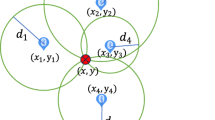Abstract
In indoor/outdoor environments, special cares need to be given to locate smartphones which are used by most of the people. Locating or tracking is valuable for those people who are in dangerous falling-situations or they are used for shopping and billing services, inside the buildings. This tracking system needs a new positioning mechanism to offer very accurate services to the special needy people. To this end, this paper presents a hybrid mechanism to locate indoors smartphones; specifically Wi-Fi access-points signals are available. The proposed mechanism incorporates onboard Wi-Fi and sensor devices including gyroscopes and accelerometers to provide accurate indoor smart phone positioning. This paper proposes an integrated approach to offer indoor smartphone positioning. The purpose of the integrated approach is to fuse multi-technologies measurements on smartphones. The mechanism uses proximity-level (based on received-signal-strength ‘RSS’ measurement) technique between the smartphone and Wi-Fi access-points which they are exist in the vicinity. Then it combines this proximity measurement with uncertainty calculations from onboard dead-reckoning measurements using Extended-Kalman filter, which can provide seamless, low cost, and improve location accuracy significantly, especially when deep indoor. This means, in deep indoor, the approach can utilize only a single Wi-Fi access-points signals as well as using prior-estimate positions based on artificial conditions. The results from different trial experiments (using Android-based smartphones) show that around 2.5-m positioning accuracy can be obtained.














Similar content being viewed by others
References
Radaelli, L., Moses, Y., & Jensen, C. S. (2014). Using cameras to improve wi-fi based indoor positioning. In International symposium on web and wireless geographical information systems, 2014 (pp. 166–183).
Yang, L., Ren, Y., & Zhang, W. (2016). 3D depth image analysis for indoor fall detection of elderly people. Digital Communications and Networks, 2(1), 24–34.
Obile, W. (2016). Ericsson mobility report, Report 3, February, 2016.
Huang, Y., Wang, R., Xu, Z., Chen, D., & Qin, H. (2016). DCIL: Devices collaboration indoor localization with soft AP. Ad Hoc and Sensor Wireless Networks, 30(1), 47–64.
Garcia, M., Martinez, C., Tomas, J., & Jaime, L. (2007). Wireless sensors self-location in an indoor WLAN environment. In International conference on sensor technologies and applications, 2007 (pp. 146–151).
Halgurd, S. M., Ihsan, A. L., Kayhan, Z. G., & Jaime, L. (2016). Seamless outdoors–indoors localization solutions on smartphones: Implementation and challenges. ACM Computing Surveys, 48(4), 53.
Rea, M., Cordobés De La Calle, H., Giustiniano, D., Domenico, G., Pierluigi, G., & Spilios, M. (2017). Ingrid, integration of WiFi ToF positioning system in the open, flexible and adaptive WiSHFUL architecture. In ACM international workshop on wireless network testbeds, experimental evaluation & characterization, 2017.
Garcia, M., Tomas, J., Boronat, F., & Lloret, J. (2009). The development of two systems for indoor wireless sensors self-location. Ad Hoc & Sensor Wireless Networks, 8(3–4), 235–258.
Tran-Quang, V., Ngo-Quynh, T., & Jo, M. (2016). A Lateration-localizing algorithm for energy-efficient target tracking in wireless sensor networks. Ad Hoc and Sensor Wireless Networks, 34(1–4), 191–220.
Nasar, A. W., Bokhari, S. M. A., Kasi, J. K., & Ajab, K. (2017). Implementation of visible light communication based system for indoor positioning. International Journal of Science and Technology, 3(1), 67–80.
Lloret, J., Tomas, J., Garcia, M., & Canovas, A. (2009). A hybrid stochastic approach for self-location of wireless sensors in indoor environments. Sensors, 9(5), 3695–3712.
Nils, B., Michael, J., & Sebastian, S. (2015). Indoor smartphone localization with auto-adaptive dead reckoning. In The tenth international conference on systems, Barcelona, Spain, 2015 (pp. 125–131).
Tian, Z., Zhang, Y., Zhou, M., & Liu, Y. (2014). Pedestrian dead reckoning for MARG navigation using a smartphone. EURASIP Journal on Advances in Signal Processing, 1, 1–9.
Kaur, P., & Sharma, S. (2014). Google Android a mobile platform: A review. In Recent advances in engineering and computational sciences (RAECS), March, 2014.
Daniş, F. S., & Cemgil, A. T. (2017). Model-based localization and tracking using bluetooth low-energy beacons. Sensors, 17(11), 2484.
Gu, Y., Hwang, I., Liu, S., & Wei, Y. (2017). WiFi-fingerprint based indoor localization map. US Patents 9,635,516, April 25, 2017.
Li, H., Chen, X., Jing, G., Wang, Y., Cao, Y., Li, F., et al. (2015). An indoor continuous positioning algorithm on the move by fusing sensors and Wi-Fi on smartphones. Sensors, 15(12), 31244–31267.
Lee, S., Cho, B., Koo, B., Ryu, S., Choi, J., & Kim, S. (2015). Kalman filter-based indoor position tracking with self-calibration for RSS variation mitigation. International Journal of Distributed Sensor Networks, 2015, 10.
Vasisht, D., Kumar, S., & Katabi, D. (2016). Decimeter-level localization with a single WiFi access point. In 13th USENIX symposium on networked systems design and implementation, 2016 (pp. 165–178).
Halgurd, S. M., Ali, A., Naseer, A., & Ihsan, L. A. (2016). UNILS: Unconstrained indoors localization scheme based on cooperative smartphones networking with onboard inertial, Bluetooth and GNSS devices. In IEEE/ION position, location and navigation symposium, 2016 (pp. 129–136).
Newman, N. (2014). Apple iBeacon technology briefing. Journal of Direct, Data and Digital Marketing Practice, 15(3), 222–225.
Andò, B., Baglio, S., Campisi, S., Lombardo, C. O., Marletta, V., & Pergolizzi, E. (2014). A novel tracking system for AAL based on smartphone technology. Ambient Assisted Living, Part VI, 243–250.
Lloret, J., Canovas, A., Sendra, S., & Parra, L. (2015). A smart communication architecture for ambient assisted living. IEEE Communications Magazine, 53(1), 26–33.
Author information
Authors and Affiliations
Corresponding author
Ethics declarations
Conflict of interest
The authors this paper certify that they have NO affiliations with or involvement in any organization or entity with any financial interest (such as honoraria; educational grants; participation in speakers’ bureaus; membership, employment, consultancies, stock ownership, or other equity interest; and expert testimony or patent-licensing arrangements), or non-financial interest (such as personal or professional relationships, affiliations, knowledge or beliefs) in the subject matter or materials discussed in this manuscript.
Rights and permissions
About this article
Cite this article
Maghdid, S.A., Maghdid, H.S., HmaSalah, S.R. et al. Indoor human tracking mechanism using integrated onboard smartphones Wi-Fi device and inertial sensors. Telecommun Syst 71, 447–458 (2019). https://doi.org/10.1007/s11235-018-0517-2
Published:
Issue Date:
DOI: https://doi.org/10.1007/s11235-018-0517-2




